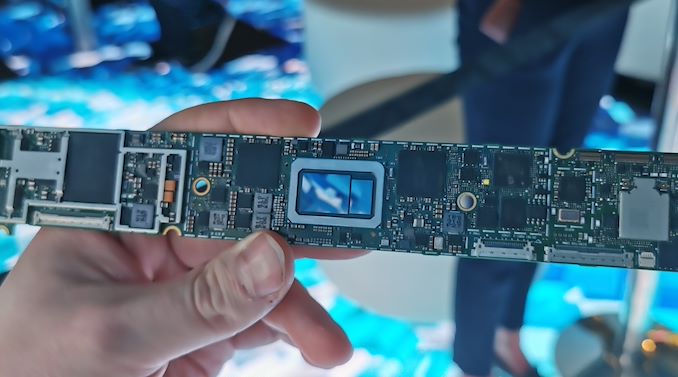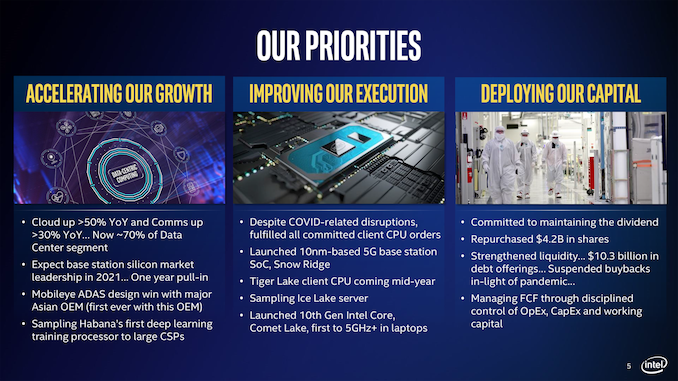Intel: Tiger Lake Client CPUs Coming Mid-Year
by Ryan Smith on April 24, 2020 10:00 AM EST
Along with detailing the nuts and the bolts of their Q1 2020 earnings, as part of Intel’s financial presentation, the company also offered a quick update on their upcoming Tiger Lake client CPUs. In short, the company is now preparing for volume production of the chips, and expects to being shipping them to OEMs mid-year.
Intel first unveiled Tiger Lake back at CES 2020 early this year, where the company briefly detailed the architecture while showing off a device using a prototype chip. Tiger Lake will be based on Intel’s latest Core CPU architecture, and will also be the first CPU from the company to integrate an iGPU based on their new Xe-LP graphics architecture. The chips will be based on a newer version of Intel’s 10nm manufacturing process than what’s used in the current ice Lake chips, which Intel is calling their 10+ process. At the time, Intel was promising that Tiger Lake devices would show up by the holidays, a similar time frame as 2019’s Ice Lake launch.
All told then, Intel’s most recent update is right in-line with their previous promises. With Tiger Lake being another mobile-first launch, OEMs need to receive chips well in advance of when consumer products will reach the store shelves, both to give OEMs the necessary time to finalize their designs, as well as to build up a suitable stockpile of devices for a proper retail launch. So, as it always needs to be said when talking about Intel’s timelines for manufacturing, while Tiger Lake chips will be shipping mid-year, we’re not currently expecting devices any sooner than what Intel has previously discussed.
Finally, if everything goes according to plan or Intel, it looks like the Tiger Lake launch should be a higher volume affair than Ice Lake’s. Cognizant of Ice Lake’s slow ramp-up and launch in 2019, Intel is telling investors that they are holding twice as many Tiger Lake CPUs in reserve as compared to Ice Lake. The company does need to master its updated 10+ process to get there, but with any luck, Intel’s 4+ years of playing with 10nm may finally pay some better dividends as they bring up their latest process.
#ontherun #TigerLake pic.twitter.com/Dhm1TwlcjV
— 𝐷𝑟. 𝐼𝑎𝑛 𝐶𝑢𝑡𝑟𝑒𝑠𝑠 (@IanCutress) January 8, 2020











140 Comments
View All Comments
Deicidium369 - Monday, May 4, 2020 - link
Yeah, pretty obvious. AMD GOOD! INTEL BAD! NVIDIA BAD! AMD OUTSELL INTEL, but AMD just being modest and not really reporting the revenue ...Spunjji - Monday, April 27, 2020 - link
@Deicidium369 - TGL is indeed wider and deeper than Skylake, but the comparison @name99 made was to ICL, not Skylake. Is TGL substantially different from ICL? My understanding is that there were tweaks on the order of Haswell to Broadwell, rather than on the scale of Broadwell to Skylake.@close seems to have been specific in saying "*substantial* and relevant desktop/laptop architecture". ICL hasn't been on the desktop and only serves part of the laptop market, so I think their comment was accurate in those terms even if a bit unfair overall.
Of course @mode_13h would rather bash on anyone appearing to criticise Intel, facts be damned... 🙄
mode_13h - Saturday, April 25, 2020 - link
WTF, dude? I mean, if you don't consider Sunny Cove a new uArch, then I guess you're going to call every future Intel x86 core just another Skylake iteration. But that's *your* problem, not Intel's.https://en.wikichip.org/wiki/intel/microarchitectu...
29a - Sunday, April 26, 2020 - link
According to your link they are all derivatives of Sandy Bridge.From the link
"Like its predecessors, Sunny Cove focuses on extracting performance and reducing power through a number of key ways. Intel builds Sunny Cove on previous microarchitectures, descendants of Sandy Bridge. For the core to increase the overall performance, Intel focused on extracting additional parallelism. "
Qasar - Sunday, April 26, 2020 - link
if they are all derivatives are sandy bridge, and even intel calls them 10th gen, how can they be a new architecture ? a new architecture would be going from Bulldozer-Excavator to Zen, correct ?name99 - Monday, April 27, 2020 - link
micro-architecture has a specific technical meaning, just like architecture has a specific technical meaning.If you want to treat it as a marketing term so that you can wave your tribal flag; if your goal is to score rather than to understand; go right ahead.
But be aware that the people who actually understand these issues will judge you accordingly. Respect, once lost, is hard to regain...
Qasar - Tuesday, April 28, 2020 - link
name99, still doesnt explain why intel calls it 10th gen and not 1st gen, sounds like its still based on the previous architecture to me.AshlayW - Monday, April 27, 2020 - link
Comet Lake, for desktop computing - which is unreleased as of now, is still based on the 5-year old Skylake design. The OP is correct apart from a few mobile parts. Even Intel's latest mobile series have Skylake-class cores in them.Zen2 is already superior to Skylake in essentially every metric, especially from an engineering/economics/efficiency perspective, while managing to be more performant per clock. By the time post-Skylake-class cores are fully deployed in all of Intel's product stacks; Zen3 will be shipping, and Zen4 on 5nm (which is in test/sampling right now) will be on the Horizon.
I want Intel to return to making decent products, but you can't argue the last 5 years of rehash have been decent products. Wake me up when they have the perf/watt, the perf/dollar and the features that AMD is offering - and not before.
Lisa Su / AMD have done more for client/.consumer computing in the last 3 years than Intel has done in the last Decade. It's probably because Dr. Su has is a computer science engineer, knows what she's talking about, and how to make a good processor - unlike Intel, which is run by greedy corporate bean-counters always seeking to rip the consumer (and OEMs) off as much as possible.
Spunjji - Tuesday, April 28, 2020 - link
@AshlayW You're right about the last part, which I think it what chafes the fanboys most of all. We were stuck with quad-core on desktop and dual-core in low-power laptops for years until AMD announced Ryzen with 8 cores on desktop and 4 down the whole mobile stack, at which point Intel magically found a way to give us competitive products at similar prices. They got used to walking, and the moment they had to get back to running they tripped over their shoelaces.Luckily for them the US rewards sheer size over and above all other metrics.
Deicidium369 - Monday, May 4, 2020 - link
1st paragraph - corrent2nd paragraph - LMAO
4th paragraph - LMAO - Lisa Su has a company based on making cheap chinese copies of what Intel (full of engineers) has made. She is better than her predecessor, so before the dumpster was full on blazing fire, and now the blaze is contained but still burning.